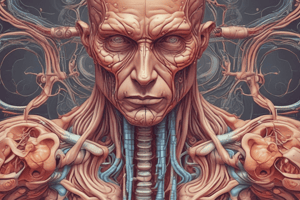Podcast
Questions and Answers
What is the primary function of the interstitial cells in the male reproductive system?
What is the primary function of the interstitial cells in the male reproductive system?
- To regulate body temperature
- To store sperm
- To produce sperm
- To produce testosterone (correct)
What is the term for the descent of the testes?
What is the term for the descent of the testes?
- Gubernaculum testis (correct)
- Spermatic cord
- Cryptorchidism
- Inguinal canal
What is the name of the tube that connects the ovary to the uterus?
What is the name of the tube that connects the ovary to the uterus?
- Fallopian tube (correct)
- Broad ligament
- Ovarian ligament
- Uterine tube
What is the term for the mature ovarian follicle?
What is the term for the mature ovarian follicle?
What is the term for the muscular layer of the uterus?
What is the term for the muscular layer of the uterus?
What is the term for the surgery to cut or tie the vas deferens?
What is the term for the surgery to cut or tie the vas deferens?
What is the primary function of the epididymis in the male reproductive system?
What is the primary function of the epididymis in the male reproductive system?
Which structure in the female reproductive system is responsible for the production of estrogen?
Which structure in the female reproductive system is responsible for the production of estrogen?
What is the name of the muscular layer that surrounds the uterus?
What is the name of the muscular layer that surrounds the uterus?
Which part of the penis is responsible for sensation during sexual arousal?
Which part of the penis is responsible for sensation during sexual arousal?
What is the term for the abnormal growth of endometrial tissue outside the uterus?
What is the term for the abnormal growth of endometrial tissue outside the uterus?
Which structure in the female reproductive system is responsible for the secretion of lubricating fluids during sexual arousal?
Which structure in the female reproductive system is responsible for the secretion of lubricating fluids during sexual arousal?
Flashcards are hidden until you start studying
Study Notes
Male Reproductive System
- The scrotum contains the testes, which produce sperm cells.
- Seminiferous tubules are the site of sperm production, and interstitial cells produce testosterone.
- Epididymis stores and transports sperm cells.
- Ductus deferens (vas deferens) is a muscular tube that transports sperm cells during ejaculation.
- Cremaster muscle regulates the position of the testes.
- Spermatic cord is a bundle of nerves, blood vessels, and ductus deferens.
- Inguinal canal is a passageway for the spermatic cord.
- Seminal vesicles/seminal glands produce seminal fluid.
- Ejaculatory duct is a short muscular tube that empties into the urethra.
- Prostate gland produces a protein-rich fluid that makes up semen.
- Bulbo-urethral glands produce a mucous secretion that helps lubricate the urethra.
- Urethra is the tube that carries semen and urine out of the body.
- Penis consists of the glans, corpora cavernosa, and corpus spongiosum.
- Descent of the testes occurs during fetal development, guided by the gubernaculum testis.
Female Reproductive System
- Ovary is the female reproductive organ that produces eggs.
- Germinal epithelium is the layer of cells that gives rise to egg cells.
- Cortex is the outer layer of the ovary where follicles develop.
- Estrogen is produced by the ovary and regulates the female reproductive cycle.
- Primordial and secondary follicles are stages in the development of a mature ovarian follicle (Graafian follicle).
- Antrum is the fluid-filled cavity of a mature follicle.
- Corpus luteum produces progesterone, which regulates the uterine cycle.
- Corpus albicans is the scar tissue that forms after a follicle has ruptured.
- Uterine (Fallopian) tube is the tube that connects the ovary to the uterus.
- Fimbriae are finger-like projections that catch the egg after ovulation.
- Infundibulum is the funnel-shaped part of the uterine tube that captures the egg.
- Ampulla is the widest part of the uterine tube where fertilization often occurs.
- Isthmus is the narrow part of the uterine tube that connects the ampulla to the uterus.
- Uterus is the muscular organ that supports fetal development during pregnancy.
- Uterine cavity is the space within the uterus where a fetus develops.
- Endometrium is the layer of tissue that lines the uterine cavity.
- Myometrium is the layer of smooth muscle that makes up the uterine wall.
- Perimetrium is the outermost layer of the uterus.
- Cervix is the lower part of the uterus that opens into the vagina.
- Round ligament, ovarian ligament, and broad ligament are supportive ligaments of the uterus.
- Vagina is the muscular tube that connects the cervix to the outside of the body.
- Vaginal rugae are folds in the vagina that allow it to stretch during intercourse.
- Clitoris is the small organ that responds to sexual stimulation.
- Mons pubis is the fatty tissue that covers the pubic bone.
- Labia majora and labia minora are the folds of skin that surround the vagina.
- Breast tissue consists of mammary glands, lactiferous ducts, nipples, and areolae.
Uterine and Ovarian Cycles
- Uterine cycle is the series of changes that occur in the uterus to prepare for a fertilized egg.
- Ovarian cycle is the series of changes that occur in the ovary to produce an egg.
Clinical Information
- Cryptorchidism is a condition in which the testes fail to descend into the scrotum.
- Endometriosis is a condition in which uterine tissue grows outside the uterus.
- Vasectomy is a surgical procedure that cuts the ductus deferens to prevent fertilization.
- Tubal ligation is a surgical procedure that blocks the uterine tubes to prevent fertilization.
Studying That Suits You
Use AI to generate personalized quizzes and flashcards to suit your learning preferences.




